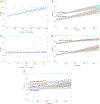Duration of Exposure Among Close Contacts of Patients With Infectious Tuberculosis and Risk of Latent Tuberculosis Infection
- PMID: 32044987
- PMCID: PMC8851607
- DOI: 10.1093/cid/ciz1044
Duration of Exposure Among Close Contacts of Patients With Infectious Tuberculosis and Risk of Latent Tuberculosis Infection
Abstract
Background: Predictors of latent tuberculosis infection (LTBI) among close contacts of persons with infectious tuberculosis (TB) are incompletely understood, particularly the number of exposure hours.
Methods: We prospectively enrolled adult patients with culture-confirmed pulmonary TB and their close contacts at 9 health departments in the United States and Canada. Patients with TB were interviewed and close contacts were interviewed and screened for TB and LTBI during contact investigations.
Results: LTBI was diagnosed in 1390 (46%) of 3040 contacts, including 624 (31%) of 2027 US/Canadian-born and 766 (76%) of 1013 non-US/Canadian-born contacts. In multivariable analysis, age ≥5 years, male sex, non-US/Canadian birth, smear-positive index patient, and shared bedroom with an index patient (P < .001 for each), as well as exposure to >1 index patient (P < .05), were associated with LTBI diagnosis. LTBI prevalence increased with increasing exposure duration, with an incremental prevalence increase of 8.2% per 250 exposure hours (P < .0001). For contacts with <250 exposure hours, no difference in prevalence was observed per 50 exposure hours (P = .63).
Conclusions: Hours of exposure to a patient with infectious TB is an important LTBI predictor, with a possible risk threshold of 250 hours. More exposures, closer exposure proximity, and more extensive index patient disease were additional LTBI predictors.
Keywords: close contacts; epidemiology; exposure; exposure hours; latent tuberculosis infection.
Published by Oxford University Press for the Infectious Diseases Society of America 2020.
Conflict of interest statement
Figures

References
-
- Horsburgh CR Jr, Rubin EJ. Clinical practice. Latent tuberculosis infection in the United States. N Engl J Med 2011; 364:1441–8. - PubMed
-
- Guidelines for the investigation of contacts of persons with infectious tuberculosis: recommendations from the National Tuberculosis Controllers Association and CDC. MMWR Morb Mortal Wkly Rep 2005; 54(RR-15):1–37. - PubMed
-
- Reichler MR, Reves R, Bur S, et al.; Contact Investigation Study Group. Evaluation of investigations conducted to detect and prevent transmission of tuberculosis. JAMA 2002; 287:991–5. - PubMed
-
- World Health Organization. Recommendation for investigating contacts of persons with infectious tuberculosis in low- and middle-income countries. Geneva, Switzerland: World Health Organization; 2012. Publication no. WHO/HTM/TB/2012.9. - PubMed
Publication types
MeSH terms
Grants and funding
LinkOut - more resources
Full Text Sources
Medical

